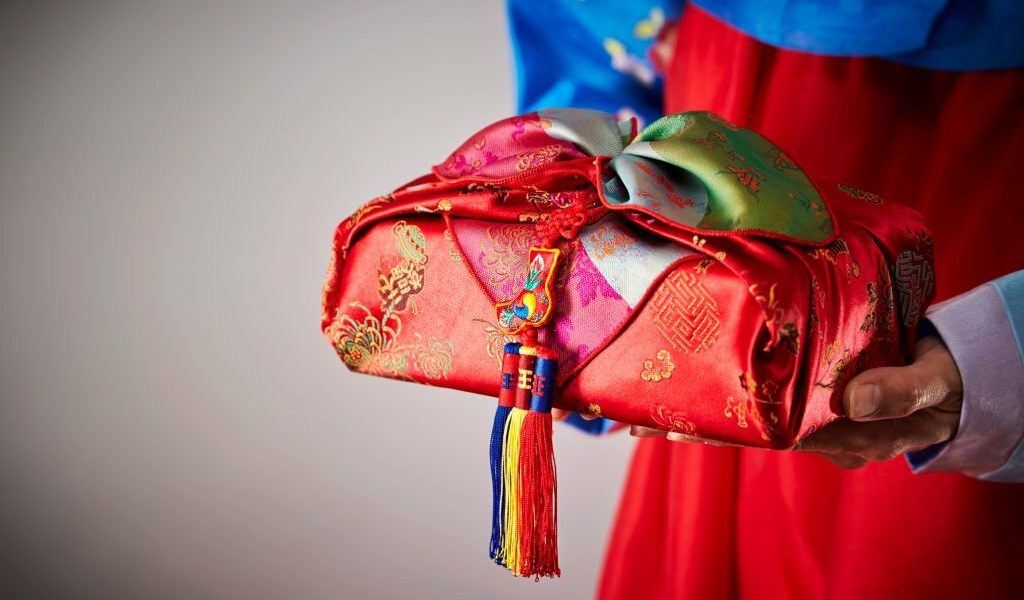With a rich ancient culture and incredible traditions, customs, and practices, South Korea stands as one of the most interesting communities in the world! Even as it takes center stage in the mainstream world, there are still many things a lot of people don’t know about Korean culture. One of those is the fascinating practice of bojagi!
If you’re looking to up your cultural know-how, then sit back and relax as we tell you all about this centuries-old custom!
What’s Bojagi?

First off, what is bojagi in the first place? Well, even its name can tell us a great deal about the practice’s history. “Bojagi” comes from the characters “bok,” meaning luck, and “bo” meaning happiness or fortune. That means we can see “bojagi” as “the wrapping of luck!” This stems from a centuries-old belief that wrapping objects in cloth protected them and ensured that “good luck” stayed inside.
Bojagi refers to traditionally wrapped gifts and packages. It’s not just a practical form of gift-giving but a visually beautiful one as well, as the different cloths and tie patterns used make your gift truly one of a kind.
History Of Bojagi

Bojagi has a long history in Korean culture. Sources say the earliest evidence of this wrapping custom takes us back all the way to the Three Kingdoms Period (57 BCE to 668 CE). Back then, bojagi was mostly done as part of Buddhist customs like in sutras and tablecloths. While there is mention of bojagi from texts in this period, there is no surviving evidence of the cloths themselves.
Since its creation, bojagi has become a way for Korean women to express their creativity. They utilized different skills and stitches to create intricate patterns and pieces. These are also given as heirlooms passed down from one generation to another. By around the 1950s and 1960s, bojagi was no longer being used everyday but only for important occasions.
These days, bojagi are still pretty common and have taken on new forms that reflect more modern sensibilities. Different forms of bojagi made from more sustainable fabrics and recycled materials are now more common.
Type Of Fabrics For Bojagi
Silk

Silk was commonly used for bojagi among the elite and higher classes. Even royalty enjoyed bojagi made from silk in different shades and colors! Nowadays, silk bojagi have stepped down from their royal purposes and have become some of the most common types you can find.
Ramie, Hemp, or Cotton

Ramie, hemp, and cotton are also used in making bojagi. Ramie is a type of plant fiber that comes from East Asia. It’s prized for its incredible luster and shine. These kinds of materials were commonly used for the bojagi of commoners or the lower classes, perhaps because they were more easily obtained than the prestigious silk.
You May Also Like: All You Need To Know About Norigae
How To Wrap & Tie Bojagi

Wrapping with bojagi can look a bit complicated, but we assure you that it’s actually pretty simple to do!
- Step 1: Lay the bojagi out in a diamond shape and put your gift in the middle. It’s best if the gift is in a rectangular or square box.
- Step 2: Gather all four corners of the diamond.
- Step 3: Tie a rubber band to secure the fabric together.
- Step 4: Pull the pieces of fabric outward to make them look like petals. And that’s it!
You can also check out this short video for more detailed instructions.
Bojagi Colors & Symbolism

Colors are very important in Korean culture as they symbolize different things. The “Obangsaek” or the “Five Elements” are particularly important. They represent five directions as well as the five elements of life. While modern-day bojagi comes in all kinds of colors and patterns, these five colors still remain among the most popular.
Red
Red represents the southern direction as well as the element of fire. In today’s world, it has also become a color of hope and unity.
Blue
On the other hand, we have blue which stands for the eastern direction as well as for the element of wood. It is also commonly paired with the color red to balance the Yin (female) and Yang (male) elements. This is done to drive away negative energy and spirits, which is why you can often see this color combination during weddings. It’s even on the national flag of Korea!
Yellow
Yellow is used to represent the element of earth as well as the center direction.
Black
Black stands for the element of water and the northern direction. Nowadays, it’s also seen as the color that symbolizes modernism as well as Western sensibilities and international appeal.
White
Of all the colors, white is perhaps the most meaningful according to Korean culture. It represents the western direction as well as the element of metal. Back in the day, white was seen as the very foundation of humanity. It represents innocence, humility, and purity. Back in the Joseon Era, many Koreans wore white-colored clothes as a way to symbolize their devotion to all things pure and natural.
Where To Buy Bojagi?

Bojagi can be found in most traditional Korean craft stores all across the country. They’re commonly found in big marketplaces that sell a variety of different items for a cheap price.
There are also private companies like Fold and Tie that offers bojagi-wrapping services for special events like weddings and birthdays! What’s more, they also offer classes so you can learn all about the art of gift-wrapping yourself.
Meanwhile, you can also purchase traditional bojagi right from the comfort of your own home. You can check out for example this online shop that offers beautiful products at an affordable price.
Bojagi Etiquette

If you are lucky enough to receive a bojagi, know that you have been given a very prestigious and special gift. Nowadays, bojagi takes the place of wrapping paper as gifts are usually covered in these special cloths. However, the bojagi itself is not just a wrapping paper but gift in itself! That’s why it’s considered good etiquette that you do not throw away bojagi if you receive it as part of a gift.
You can dust it off, wash it, or even iron it so you can use it in many other ways: as decoration, as a carrying bag, as another gift wrapper, and so on!
—
We hope you enjoyed our article on the bojagi! Which fun fact surprised you the most?
Korean culture is filled with incredible traditions and customs that reflect the people’s unique sensibilities. Bojagi lives on as a celebration of both aesthetic and practical purposes. Nowadays, it’s a celebrated art form that’s been incorporated into the modern era.
If you liked this, make sure to check out our other cultural explainers like why Koreans bow and everything you need to know about Korean first birthday traditions!

